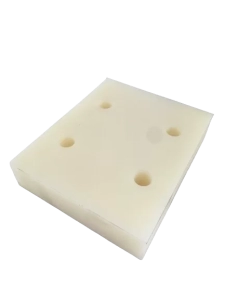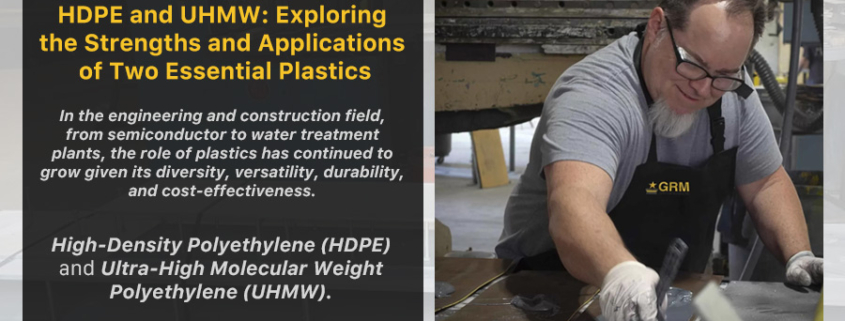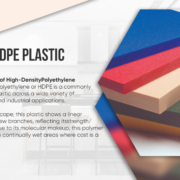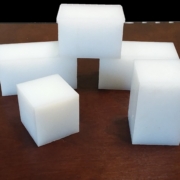HDPE and UHMW: Exploring the Strengths and Applications of Two Essential Plastics
In the engineering and construction field, from semiconductor to water treatment plants, the role of plastics has continued to grow given its diversity, versatility, durability, and cost-effectiveness. Engineers face ongoing challenges of selecting the latest materials to ensure the longevity of their project. Two widely effective types of plastic for construction and industrial projects are High-Density Polyethylene (HDPE) and Ultra-High Molecular Weight Polyethylene (UHMW). While both are polyethylene based, HDPE and UHMW have distinct properties and applications.
Let’s clarify HDPE Plastic and UHMW Plastic differences to highlight advantages of each one.
Understanding HDPE Plastic
Definition and Composition
High-Density Polyethylene (HDPE) is a thermoplastic polymer made from petroleum. It’s known for its high strength-to-density ratio, which makes it a preferred material for a wide range of applications. The density of HDPE typically ranges from 0.93 to 0.97 g/cm³, and its structure exhibits a low degree of branching, offering stronger intermolecular forces and tensile strength.
Advantages of HDPE Plastic
Durability and Strength:
HDPE plastic is highly durable and resistant to impact, which makes it suitable for products that require strength and longevity. Items such as piping, bearing, break and wear pads.
Chemical Resistance: HDPE exhibits excellent resistance to various chemicals, including acids, alcohols, and bases. This property makes it an ideal choice in petrochemical process and piping applications.
Lightweight: Despite its strength, HDPE is relatively lightweight in comparison to other products maintaining the equivalent strength, which also reduces the transportation and handling costs.
Recyclability: These are the one of the most commonly recycled plastics, often reprocessed into new products like pipes and plastic lumber to help support sustainability efforts.
Cost-Effectiveness: The manufacturing process of HDPE is straightforward and cost-effective, making it a popular choice in various industries.
Common Applications of HDPE
HDPE is used in a wide range of applications, including:
- Packaging: Bottles, Containers, and Packaging
- Piping Systems: For Water, Gas, and Sewage
- Construction: Bearing and Wear Pads, Galvanic Breaks,Tanks
- Consumer Goods: Toys, Household Goods, and Furniture
Understanding UHMW Plastic
Definition and Composition
Ultra-High-Molecular-Weight Polyethylene (UHMW) is a subset of polyethylene with extremely long chains, resulting in a molecular weight numbering in the millions. The long chains serve to transfer load more effectively to the polymer backbone, making UHMW the toughest of all polyethylene variants, perfect for many industrial and marine applications.
Advantages of UHMW Plastic
Exceptional Wear Resistance:
UHMW plastic is renowned for its outstanding abrasion and corrosion resistance, which is why it’s often used in applications where durability against wear is crucial.
Low Friction Coefficient of UHMW makes it suitable for use in sliding applications, or any solution looking to reduce energy loss and wear on moving parts.
High Impact Strength:
UHMW’s high impact strength makes it ideal for applications that require both toughness and the ability to withstand heavy loads or impacts.
Chemical Resistance:
Like HDPE, UHMW is resistant to a wide range of chemicals, making it suitable for use in harsh environments, resisting a wide range of caustics and acids.
Low Water Hydrophobic properties offer very low water absorption, to help maintain the integrity and longevity of the material in wet environments.
Common Applications of UHMW
UHMW is often used in industrial applications that demand high durability and corrosion resistance, such as:
- Conveyor Systems: For guiding and supporting belts
- Marine Equipment: Dock Fenders and Buoys
- Industry: Sliding Components, Gears, Breaks, and Bearings
- Medical Devices: Prosthetics and Implants
Key Differences Between HDPE and UHMW
While HDPE and UHMW share some similar properties, they are distinctly different in several key areas, as outlined below.
Molecular Weight:
The molecular weight of UHMW is significantly higher than that of HDPE, which gives it superior wear resistance and toughness.
Applications:
Due to its exceptional wear resistance and low friction, UHMW is more suited for industrial applications, while HDPE is commonly used in packaging and water piping.
Cost:
UHMW tends to be more expensive than HDPE, reflecting its specialized properties and applications. The additional cost is warranted if improved strength and durability are a concern.
Processing:
HDPE can be more easily processed into thin films and flexible packaging, UHMW, due to its high molecular weight, requires more specialized and costly processing techniques.
Summary
Both HDPE plastic and UHMW plastic offer unique advantages for consideration. HDPE is widely used for its strength, chemical resistance, and cost-effectiveness, making it a staple in construction and packaging. Whereas UHMW’s exceptional wear resistance and low friction properties make it indispensable in heavy-duty industrial applications.
Understanding the differences between these two materials allows engineers and designers to select the right type of plastic for their specific needs, ensuring durability, efficiency, and cost-effectiveness in their projects. Whether you’re looking at a cost-effective option or require specialized industrial grade, HDPE and UHMW provide effective solutions for consideration









